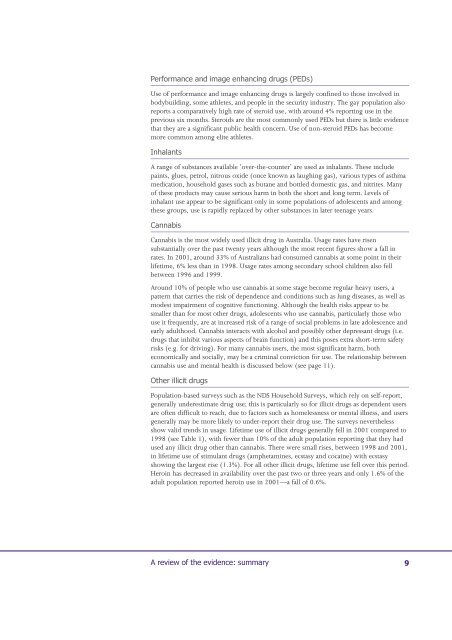Summary - Department of Health and Ageing
Summary - Department of Health and Ageing
Summary - Department of Health and Ageing
You also want an ePaper? Increase the reach of your titles
YUMPU automatically turns print PDFs into web optimized ePapers that Google loves.
Use <strong>of</strong> performance <strong>and</strong> image enhancing drugs is largely confined to those involved in<br />
bodybuilding, some athletes, <strong>and</strong> people in the security industry. The gay population also<br />
reports a comparatively high rate <strong>of</strong> steroid use, with around 4% reporting use in the<br />
previous six months. Steroids are the most commonly used PEDs but there is little evidence<br />
that they are a significant public health concern. Use <strong>of</strong> non-steroid PEDs has become<br />
more common among elite athletes.<br />
<br />
A range <strong>of</strong> substances available ‘over-the-counter’ are used as inhalants. These include<br />
paints, glues, petrol, nitrous oxide (once known as laughing gas), various types <strong>of</strong> asthma<br />
medication, household gases such as butane <strong>and</strong> bottled domestic gas, <strong>and</strong> nitrites. Many<br />
<strong>of</strong> these products may cause serious harm in both the short <strong>and</strong> long term. Levels <strong>of</strong><br />
inhalant use appear to be significant only in some populations <strong>of</strong> adolescents <strong>and</strong> among<br />
these groups, use is rapidly replaced by other substances in later teenage years.<br />
<br />
Cannabis is the most widely used illicit drug in Australia. Usage rates have risen<br />
substantially over the past twenty years although the most recent figures show a fall in<br />
rates. In 2001, around 33% <strong>of</strong> Australians had consumed cannabis at some point in their<br />
lifetime, 6% less than in 1998. Usage rates among secondary school children also fell<br />
between 1996 <strong>and</strong> 1999.<br />
Around 10% <strong>of</strong> people who use cannabis at some stage become regular heavy users, a<br />
pattern that carries the risk <strong>of</strong> dependence <strong>and</strong> conditions such as lung diseases, as well as<br />
modest impairment <strong>of</strong> cognitive functioning. Although the health risks appear to be<br />
smaller than for most other drugs, adolescents who use cannabis, particularly those who<br />
use it frequently, are at increased risk <strong>of</strong> a range <strong>of</strong> social problems in late adolescence <strong>and</strong><br />
early adulthood. Cannabis interacts with alcohol <strong>and</strong> possibly other depressant drugs (i.e.<br />
drugs that inhibit various aspects <strong>of</strong> brain function) <strong>and</strong> this poses extra short-term safety<br />
risks (e.g. for driving). For many cannabis users, the most significant harm, both<br />
economically <strong>and</strong> socially, may be a criminal conviction for use. The relationship between<br />
cannabis use <strong>and</strong> mental health is discussed below (see page 11).<br />
<br />
Population-based surveys such as the NDS Household Surveys, which rely on self-report,<br />
generally underestimate drug use; this is particularly so for illicit drugs as dependent users<br />
are <strong>of</strong>ten difficult to reach, due to factors such as homelessness or mental illness, <strong>and</strong> users<br />
generally may be more likely to under-report their drug use. The surveys nevertheless<br />
show valid trends in usage. Lifetime use <strong>of</strong> illicit drugs generally fell in 2001 compared to<br />
1998 (see Table 1), with fewer than 10% <strong>of</strong> the adult population reporting that they had<br />
used any illicit drug other than cannabis. There were small rises, between 1998 <strong>and</strong> 2001,<br />
in lifetime use <strong>of</strong> stimulant drugs (amphetamines, ecstasy <strong>and</strong> cocaine) with ecstasy<br />
showing the largest rise (1.3%). For all other illicit drugs, lifetime use fell over this period.<br />
Heroin has decreased in availability over the past two or three years <strong>and</strong> only 1.6% <strong>of</strong> the<br />
adult population reported heroin use in 2001—a fall <strong>of</strong> 0.6%.

















